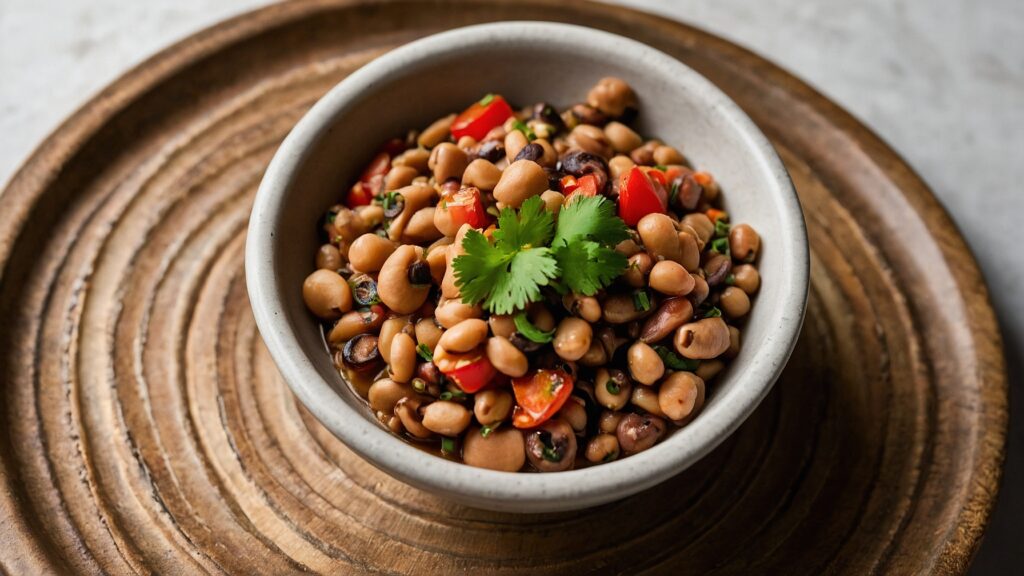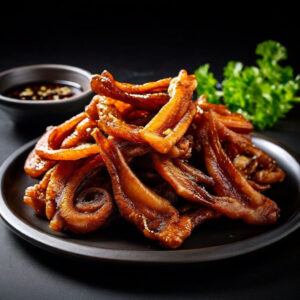Black eyed peas are a popular food for humans. But what about for cats? Can cats eat black eyed peas?
As obligate carnivores, cats have specific nutritional needs centered around meat. However, they can digest and benefit from some plant foods in moderation as well.
So should you share some of your black eyed pea salad with your feline friend? Or keep these legumes away from kitty’s bowl?
This comprehensive guide will cover everything you need to know about feeding black eyed peas to cats.
Table of Contents
Can Cats Eat Black Eyed Peas?
A few bites of black eyed peas are likely fine for most felines. Black eyed peas are packed with certain nutrients that can be beneficial for cats:
- Fiber: Black eyed peas contain around 5 grams of fiber per half cup serving. This insoluble fiber can help promote healthy digestion and regularity in cats.
- Protein: Black eyed peas provide plant-based protein, containing around 7-8 grams per half cup. While cats need meat protein, some vegetarian protein can complement their amino acid intake.
- Vitamins and minerals: Black eyed peas are a great source of important vitamins and minerals like folate, iron, zinc, and potassium. Small amounts can provide useful levels of these micronutrients for cats.
In moderation, many cats can enjoy black eyed peas as part of a balanced, meat-based diet. The fiber and nutrients may provide certain health benefits, though cats should not get a substantial amount of their daily nutrition from plant sources.
Ask your veterinarian if adding a small amount of black eyed peas to your cat’s diet could be beneficial.
Are Black Eyed Peas Bad For Cats?

While black eyed peas can be safely fed to cats in moderation, there are also some potential downsides and risks to be aware of:
Digestibility Issues
The digestive systems of cats are not adapted to processing large amounts of plant material. The fiber and complex carbs in legumes and beans can be difficult for them to digest properly.
This can lead to gastrointestinal upset, including:
- Gas
- Bloating
- Diarrhea
- Constipation
- Vomiting
Feeding black eyed peas may also make your cat’s stool smellier and more pungent than normal.
Salicylate Toxicity
One of the biggest concerns with feeding beans and legumes to cats is the risk of salicylate toxicity. Salicylates are natural chemicals found in many plant foods.
Black eyed peas are considered a moderate to high source, containing around 30-50 mg per 100g serving. While a few black eyed peas are unlikely to cause toxicity on their own, levels can build up.
Symptoms of salicylate toxicity in cats include:
- Lethargy
- Vomiting
- Diarrhea
- Breathing issues
- Seizures
- Coma in severe cases
Cats with liver or kidney disease may be at greater risk. Always consult your vet before feeding significant amounts of legumes high in salicylates.
Salicylate Toxicity in Cats
Salicylates are natural chemicals produced by plants as a defense mechanism against insects, pathogens, and disease. They are found in varying levels in many fruits, vegetables, herbs, spices, teas, and beans.
Salicylates give plants anti-inflammatory and pain-relieving properties. Aspirin is actually a synthetic form of salicylate used in human medicine.
However, for cats, high levels of salicylate consumption can lead to toxicity. Some of the sources highest in these plant chemicals include:
- Spices: Cinnamon, garlic, ginger, cloves
- Herbs: Parsley, peppermint, oregano, dill
- Fruits: Raisins, prunes, apricots, berries
- Vegetables: Tomatoes, peas, bell peppers, beans
- Beverages: Herbal tea blends, green tea
The level of salicylates in black eyed peas is estimated to be around 30-50 mg per 100g. While a few peas occasionally are unlikely to cause toxicity on their own, eating beans and legumes regularly can cause levels to accumulate.
Cats with liver or kidney disease may not be able to efficiently metabolize and excrete salicylates, putting them at greater risk of toxicity.
Signs of salicylate poisoning in cats include:
- Lethargy
- Vomiting
- Diarrhea
- Panting or breathing issues
- Tremors or seizures
- Coma in severe cases
If your cat displays any concerning symptoms after eating black eyed peas or other salicylate-containing foods, bring them to the vet immediately. With prompt treatment, many cats recover fully.
How to Safely Feed Black Eyed Peas to Cats

If you want to share a small taste of your black eyed pea dish with your cat, follow these tips for safe preparation and feeding:
- Cook black eyed peas plain without added salt, oil, onions, garlic or other seasonings. The plain legumes will be safest.
- Mash or puree the peas with some water into a thick gruel. This makes them easier for cats to digest.
- Only feed cats very small quantities initially – 1-2 teaspoons to start. Monitor closely for signs of GI upset.
- Introduce gradually over a period of a few weeks, not all at once. Look for any signs of allergic reaction like itching, swelling, or skin irritation.
- Make sure black eyed peas represent only a tiny portion of your cat’s overall diet. They should still eat meat-based cat food for most of their nutrition.
- Watch your cat’s portions if feeding black eyed peas regularly, reducing their primary food intake to account for the extra calories.
- Some cats may tolerate black eyed peas well. Others may be unable to digest them. Discontinue feeding if you see signs of digestive problems.
Consult your vet before significantly altering your cat’s diet or adding new foods like black eyed peas. They can advise you based on your cat’s health, age, and individual tolerance.
Black Eyed Pea Recipes for Cats
Once you know your cat can safely tolerate black eyed peas, here are a couple recipe ideas for incorporating small amounts into their diet:
Simple Black Eyed Peas Puree
- 1/4 cup cooked black eyed peas
- 1/4 cup water
- Puree ingredients in food processor or blender until smooth.
- Let cool before feeding cat a teaspoon or two.
Black Eyed Pea and Chicken Soup
- 1/2 cup low sodium chicken broth
- 1 ounce cooked, unseasoned chicken, shredded
- 2 tablespoons cooked black eyed peas
- 1 tablespoon pureed carrot
- Simmer ingredients together 5 minutes until heated through.
- Puree until smooth.
- Feed a few spoonfuls to your cat as a treat.
When trying any new food, go slowly with the introduction. Feed a tiny amount at first and gradually increase over a period of 2-3 weeks while monitoring for any intestinal upset or allergic reaction.
Other Bean Options for Cats
In addition to black eyed peas, some other legumes may be safe for cats to eat in moderation. Good options include:
Green beans: Lower in salicylates than black eyed peas. High in fiber. Prepare plain without seasonings.
Chickpeas: Provide taurine and protein. Cook unseasoned.
Lentils: Iron-rich and palatable for some cats. Cook thoroughly.
The portion size should still be kept small, around 1-2 tablespoons or less. Pureeing makes beans easier to digest.
Always monitor your cat’s reaction when feeding legumes. Some cats tolerate them well, while others develop gas or loose stools. Stop feeding beans if you notice signs of digestive upset. And check with your vet first in case your cat has any underlying conditions.
When to Avoid Black Eyed Peas for Cats
Certain cats are better off avoiding black eyed peas, including:
- Kittens under 12 months. Their digestive systems are still developing.
- Cats with kidney disease. They have difficulty processing salicylates.
- Cats with urinary tract disorders. Extra minerals may worsen these conditions.
- Cats with inflammatory bowel disease or GI sensitivity. The fiber can further aggravate the intestines.
- Diabetic cats. Legumes are high in carbohydrates.
- Overweight or obese cats. Beans and peas are calorie dense.
- Cats with salicylate intolerance or allergies.
You should also avoid feeding black eyed peas to any cat:
- With a history of negative reactions to beans or other new foods.
- On a prescription veterinary diet for a health condition, without first consulting your vet.
- Who has been prescribed antibiotics or antifungals, as beans can interact with some medications.
- Recovering from a recent illness, infection, or surgery. Their digestive system may be compromised.
If your cat falls into any of the above categories, talk to your vet before feeding black eyed peas or introducing any new foods. They can help you determine whether small amounts could be safe, or should be avoided altogether.
Ask Your Vet Before Feeding Beans
As obligate carnivores, cats have very specific nutritional requirements. Their bodies and digestive systems are adapted for eating meat-based prey. This includes:
- High levels of protein from animal sources
- Moderate fat
- Very few carbohydrates
- Essential amino acids like taurine
While limited amounts of plant matter can be beneficial for cats, they lack the ability to properly digest larger quantities of fiber, carbs, and plant chemicals in vegetables, grains, and legumes.
Excess plant foods can interfere with the uptake of important nutrients like protein, calcium, and taurine. Over time, this can result in deficiencies.
Beans, peas, and lentils also contain anti-nutrients like phytates and tannins that can bind minerals and inhibit their absorption. Too much over a long period can lead to problems.
That’s why it’s important to have your vet involved in guiding your cat’s diet and approving any significant changes like introducing legumes. Some key reasons to consult with your veterinarian include:
- Identifying any food allergies or intolerances your cat may have.
- Ensuring your cat’s overall diet will still meet all of their nutritional requirements.
- Adjusting your cat’s primary food intake if adding higher calorie plant items.
- Making sure any current medications or supplements your cat takes are compatible with an altered diet.
- Determining appropriate serving sizes and safe introduction methods.
- Monitoring for potential negative effects and interactions.
While something like a taste of mashed black eyed peas is unlikely to be harmful for most healthy cats, only your vet can say for sure based on your individual cat’s needs and medical conditions.
The Bottom Line: Use Caution with Black Eyed Peas
Can cats eat black eyed peas? In small amounts, this treat is likely fine for most felines. But there are definite risks to be aware of, including:
- Digestibility problems leading to GI upset
- Potential for gas, diarrhea, and vomiting
- Risk of salicylate toxicity if cats eat beans regularly
- High fiber content cats are not adapted to processing
- Little nutritional value compared to meats
Cooked plain black eyed peas can be given sparingly and safely to some cats. But be very conservative with portions and monitor closely for negative reactions. They should not make up a substantial portion of your cat’s diet.
Kittens, cats with illnesses, and those on prescription food should avoid black eyed peas unless approved by a vet. And all cats will benefit from having increased peas introduced slowly and gradually.
While an occasional taste of beans can be safe for some felines, they are not an adequate meal replacement. Cats should still eat a primarily meat-based diet. The safest approach is asking your veterinarian before feeding black eyed peas or other legumes to your cat.
Frequently Asked Questions
Can black eyed peas hurt cats?
In large amounts, black eyed peas can potentially cause digestive upset and toxicity. But most cats can safely eat a few black eyed peas as an occasional treat with no problems.
Are peas bad for cats?
Peas contain salicylates and fiber that may bother some cats. But green peas have fewer risks and may be better tolerated than black eyed peas when fed sparingly.
What veggies can cats eat?
Good vegetables for cats include steamed green beans, pureed carrots, and pumpkin. Limit portions to just a few spoonfuls at a time. Avoid onions, garlic, celery, corn, and raw veggies.
Are beans a good protein for cats?
Beans and legumes have plant protein, but cats do best with animal-based protein sources like poultry, beef, fish and eggs to meet their nutritional needs.
Can cats eat chickpeas?
In small amounts, plain cooked chickpeas are unlikely to cause problems for most cats. They provide taurine and fiber. But introduce chickpeas slowly and monitor your cat while feeding them.
Are lentils safe for cats?
Cooked plain lentils are an iron-rich plant food that some cats can tolerate well as a snack. But consult your vet before adding them, and only feed cats 1-2 tablespoons max at a time.




